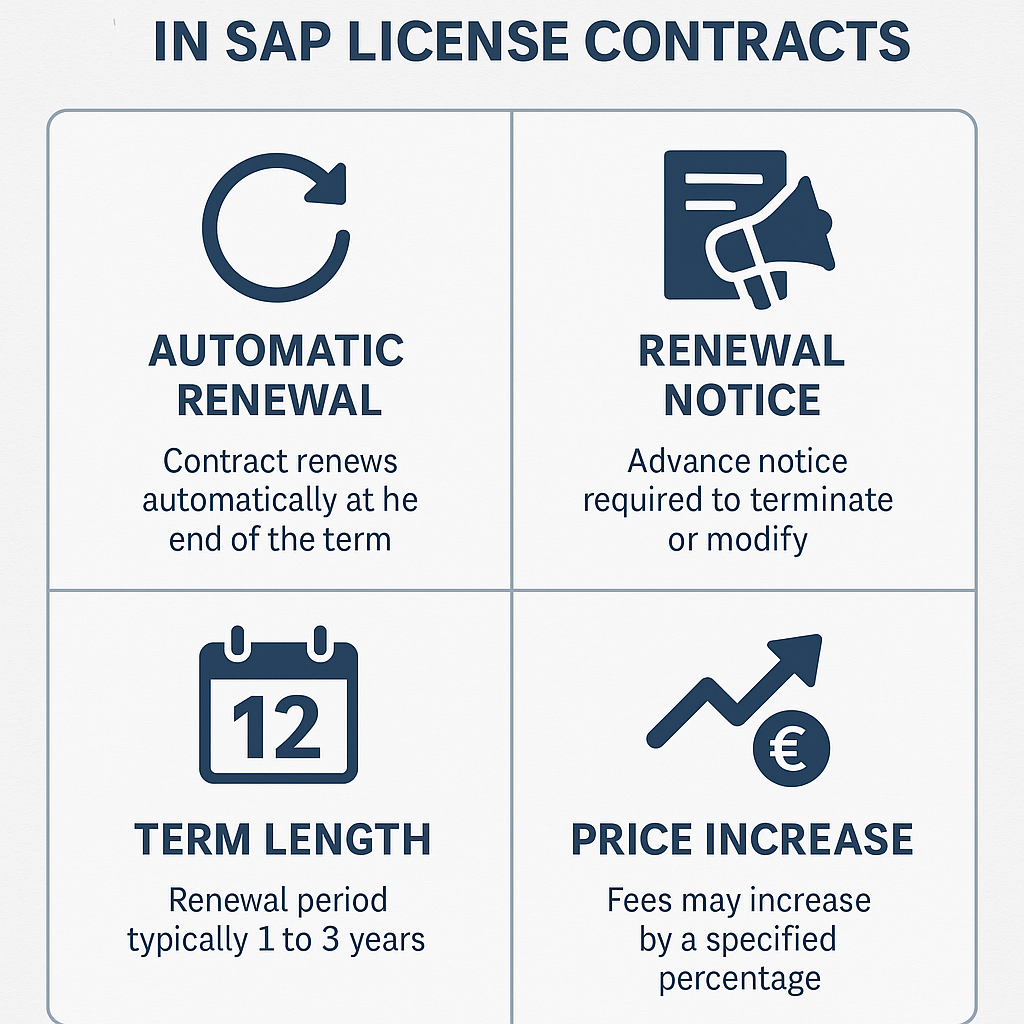
Renewal Clauses in SAP License Contracts
Renewal clauses in SAP license contracts dictate how and when your software agreements can be extended – and on what terms.
These often-overlooked clauses have a direct impact on long-term costs and flexibility. Proactively managing these terms can make the difference between a fair deal and years of overspending or being locked into an unfavorable arrangement.
Read SAP Licensing Agreements: Complete Guide with Pricing and Structures.
Automatic Renewal and Notice Periods
An automatic renewal (“evergreen”) clause means your SAP contract will extend for another term (often one year) under the same conditions unless you cancel it in advance.
This ensures continuity; however, if you miss the required notice (typically 60–90 days before the end), you will lose the opportunity to change terms and may be locked in for another year.
To avoid unwanted extensions, track all renewal dates and notice deadlines in a central calendar and set reminders in advance so you never miss any window.
Whenever possible, negotiate the removal of auto-renewal so the contract only extends with mutual agreement (a signed renewal document).
If you must accept an evergreen clause, add conditions – it renews only year-to-year (not a multi-year lock-in), and SAP must provide written notice 90 days or more before the renewal date.
License Volume and Renewal Flexibility
In both on-premises and cloud contracts, SAP typically forbids reducing license counts mid-term (on-prem support is “all or nothing” for all licenses, and cloud user subscriptions are fixed for the term).
Thus, you should negotiate true-down rights – the option to reduce license quantities or remove products at renewal without penalty. Some organizations have saved six-figure sums by removing unused licenses at renewal.
Always audit your usage before renewal to identify shelfware (unused licenses) and build your case for reductions, so you only renew what adds value.
Read Common Pitfalls in SAP Licensing Contracts
Pricing Protections and Escalation Caps
SAP fees tend to increase over time, so include safeguards in your renewal terms:
- Cap maintenance fee increases: For on-premise support, set a maximum annual uplift (e.g., no more than 3% per year). If possible, negotiate a freeze for the first year or two of the renewal term.
- Cap subscription renewal hikes: For SAP cloud subscriptions, limit the maximum price increase at renewal (for example, 5%). Ensure that any initial discount you received carries forward into the renewal term, rather than reverting to list prices.
You might also consider committing to a multi-year renewal in exchange for fixed pricing or better discounts. The key is to get all these protections in writing. Verbal assurances won’t help later – ensure that price caps and terms are explicitly stated in the contract to prevent unexpected cost increases.
Effective Renewal Negotiation Strategies
Treat the renewal as seriously as a new contract negotiation – it’s a chance to improve any suboptimal terms.
Use leverage and alternatives: Come prepared with leverage. For example, obtain quotes from third-party support or consider rival products to demonstrate to SAP that you have options.
Be prepared to reduce your SAP footprint or shift your budget if needed – a credible fallback plan puts pressure on SAP to offer better terms.
Additionally, use renewal discussions to address any troublesome terms (e.g., clarify audit rules) and request additional perks, such as training credits or support services, as part of the deal.
Recommendations
- Track renewal deadlines: Keep a calendar of all SAP contract end dates and notice deadlines, and set reminders in advance so you never miss a window.
- Audit usage before renewal: Audit your SAP usage early to identify underutilized licenses and plan reductions at renewal, so you only renew what adds value.
- Push for price protections: Negotiate caps on maintenance fee hikes and carry your current discounts into the renewal term. Lock in future rates or price ceilings in the contract to avoid unexpected cost increases.
- Build in flexibility: Negotiate terms to adjust license counts or swap products at renewal without penalty, so you’re not stuck renewing the same bundle if your needs change (e.g., after a merger).
- Use competition as leverage: Utilize market alternatives as leverage – let SAP know you have options (such as third-party support or other vendors) to encourage a better deal, and be prepared to follow through if necessary.
- Get it in writing: Get everything in writing – verbal promises (e.g., “we won’t increase much”) mean nothing later, so make sure all key terms appear in the signed contract.
FAQ
Q: What are renewal clauses in an SAP contract?
A: A renewal clause defines what happens when the initial term ends – whether the contract auto-renews, what notice is required to cancel it, and how pricing or terms may change at renewal.
Q: When should we start preparing for a renewal?
A: Begin at least 6–12 months before the contract expires to allow time for analysis and negotiation.
Q: Can we reduce our SAP licenses or subscriptions at renewal?
A: Yes – but only if your contract includes true-down rights; this clause lets you drop unused licenses or users at renewal without penalty, whereas without it SAP expects you to renew the full amount.
Q: How can we avoid price hikes during renewal?
A: Negotiate strict price caps and lock in rates ahead of time – cap annual maintenance increases, limit how much cloud fees can rise at renewal, and ensure your initial discounts carry forward.